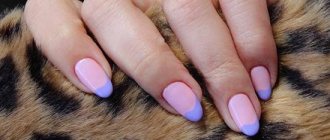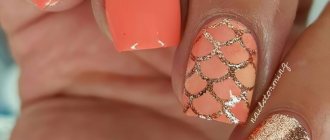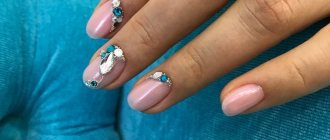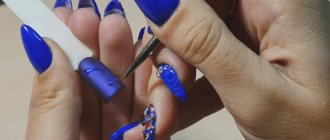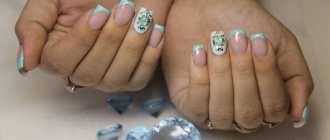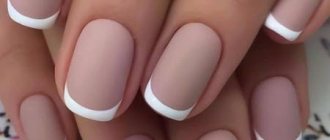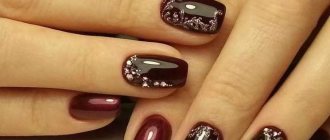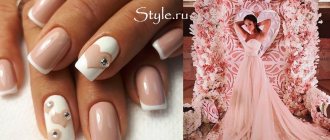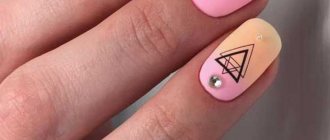A variety of nail design techniques allows every girl to find the perfect option for any occasion. Some people like classics, others prefer bright nails. But every year watercolor painting is gaining more and more popularity. This is an amazingly beautiful design that never goes unnoticed. You will learn about the execution technology, as well as the nuances in the application process, right now.
What is watercolor painting in manicure, what does it look like?
Watercolor painting represents images of various subjects with a blur effect. Translucent strokes give the design a feeling of lightness, and multi-layering adds volume and dynamics. There are several techniques for creating watercolors, which differ in the properties of the materials used.
Visually, painted designs may differ, so each master can find and master a convenient way to create drawings.
A few secrets for perfect results
- In order for paints to give a fashionable translucent effect, they should be diluted with water in a large ratio.
- An easy technique will help you create actual stains. After applying the first sketches, you should dry the paint and begin to blur the edges in the desired direction using a wet brush. Now, when a beautiful pattern appears, you need to wait for it to dry again and finally give it clear shapes with a thin brush.
- By blurring, you can lighten some areas, thereby creating a highlight and three-dimensional effect.
- Nowadays it is important to create watercolor paintings on white gel polish. This will make the drawing more expressive.
- Experiment with brush sizes, angle and pressure - this is how unique designs are created.
- When the varnish has not yet dried, you can diversify your manicure with various decor: sparkles, mica, foil or sequins.
Interesting: Manicure in boho style
In our photo selection you could look at the most current ideas for manicure with watercolors. We hope you were able to choose for yourself the most exquisite and original nail design using this magnificent technique.
Watercolor painting techniques
Watercolor on nails can be done step by step using several techniques.
Depending on the materials used, there are 3 methods:
- “dry” or blur technique;
- painting with gel polishes;
- watercolor "on wet".
The blur technique involves applying paints to a surface and blurring them with water or alcohol to obtain a transparent texture and create light and shade. Each stage does not require drying in a lamp, since the material dries in the open air. Experienced professionals recommend using a brush with natural bristles and a sharp tip.
Painting with gel polishes requires more time, artistic skills, knowledge of light and shade and the basics of color. Each step requires intermediate polymerization. Such images look more voluminous and realistic. To do this, gel polishes are mixed with the top coat and with each other. Drawing is done with brushes of various sizes with synthetic bristles.
Watercolor “wet on wet” is one of the fastest design options to execute. Using special materials, the master only sets the direction of the image. Connecting with each other, they form patterns and designs that cannot be repeated.
Techniques for painting nails with watercolors
To make a manicure look good on your hands, you need to master the correct techniques for creating a watercolor design.
These include:
- Wash. Thanks to this technique you can create bright and colorful flowers. A pastel shade is applied to the nails, which must be heavily diluted with water. After the first layer has dried, apply the second and third. Consequently, the midtones will become deeper. Attention! There is no need to apply a fourth coat.
- Wet. Stain is carefully applied to the paint layer that has not yet dried, which can be done several times. The main thing to note is the very smooth transitions for which this manicure was created. If you need to intensify the color in some areas, you should also use the brush on a "wet" layer.
- Monochrome staircase. In any situation, designs made in one color look advantageous on nails. This type of work is quick and easy to do, and the result will please you for a long time. First you need to draw the outlines and let them dry a little. Next, you need to moisten the brush in water and fill the internal spaces. At the end of the work, draw the outlines again for greater clarity. Abstract patterns look great in this technique.
- Colored glass. The principle of performing the technique is very similar to that mentioned above. The key difference is that stained glass is difficult to imitate, requiring mica and the use of a color palette in some works.
- Watercolor gel polishes on French nails. The typical French manicure, already loved by fashionistas, has been reworked by masters: now it is used as a canvas for watercolors. Moreover, the result is very interesting.
- White watercolor strokes. To perform this technique you will need a flat brush and white watercolor. Apply a little white polish to the edge of the nail. You can also use a medium sized brush and make small strokes to change the background of the image.
- Blur with a flat brush. Floral design can be complemented by the amazing property of watercolor to blur even with a small amount of water. To do this, you need to take the desired shade and shadows with a brush. This way you can achieve a color change.
- Double strike technique. Ideal for drawing three-dimensional flowers that combine different shades. The execution process is very simple: 2 colors are applied to the brush, which do not mix with each other. And with each contact with the nail, a double stroke is obtained, consisting of several highlights at the same time.
Materials for manicure and the subtleties of working with them
Watercolor on nails (step-by-step drawing diagrams are presented later in the article) are done using several types of materials:
- gel polish;
- watercolor gel polish;
- acrylic paint;
- watercolor drops;
- artistic watercolor.
Despite the fact that the materials are used to create images of the same watercolor style, each of them has features in its application. Differences in the chemical composition and density of the material also determine the variety of effects.
Watercolor gel polish
These varnishes are the usual gels in bottles with a brush. Their feature is a chemical formula that allows pigments of different shades to interact. Spreading over the surface of the nail, they create patterns. A few drops spread into a composition visually similar to a flower or reptile skin. This depends on the size, location and volume of the drop.
The material is polymerized by exposure to ultraviolet rays on the photo-initiators it contains.
Acrylic paint
This material is a pigment (usually available in tubes) for painting. The paint is applied to a matte surface, dries in the open air, and dissolved with water. Acrylic paints diluted with water have the slowest drying speed. Nail technicians rarely use acrylic paints for watercolor painting in practice. Their density is more suitable for Chinese painting using flat brushes with an angled angle.
Gel polish
This is a colored nail coating that requires curing in a lamp. It may have varying degrees of pigment density depending on the manufacturer and the effect. The material has a wide palette of shades and is often used for painting. Watercolor painting on nails using conventional gel polishes is performed step by step with intermediate drying of each applied layer. Otherwise, the pigment will mix and create a feeling of untidiness.
This technique is considered the most difficult, since to create light and shade it is necessary to dilute densely pigmented gel polish with top coat or its other shades. You can make the task easier by using special patterns (stencils).
Paint for painting “Watercolor drops”
This is a colored liquid in a bottle with a brush. The basis of “Watercolor drops” is an alcohol solution. Thanks to this feature, they have a high drying rate on the surface and do not require polymerization. The liquid has a narrow palette (usually no more than 10-15 colors). However, by mixing shades you can get new colors.
You can create chaotic designs and textures with a brush from a bottle, without using additional tools. This is a big plus when designing at home.
Artistic watercolor in ditches
This is the most common form of watercolor. Its basis is pigment and plasticizers. It is available in most art stores. A wide palette of shades allows you to create designs of any complexity. It is sold in the form of briquettes or sets, activated by water.
There are several factors that repel beginners when using artistic paints in painting:
- selecting the right combination of water and pigment;
- adjusting the amount of paint on the brush;
- difficulties in distributing material in the right direction;
- low drying speed.
Abstraction
Complete freedom of creativity is given by design in the abstract style with its inherent versatility and individuality. Today, more and more fashionistas adhere to the principle of “not like everyone else” in manicure and choose an original manicure for self-expression.
Chaotic stains in watercolor technique are just such an option. It allows you to use several favorite colors and techniques at once, and does not limit the choice of decor. You can give free rein to your imagination and combine careless brush strokes with watercolor drops, geometry and gold accents. The power of abstract art lies in the ability to transform a couple of colored lines into a real work of art.
The trend for the 2022 season is a combination of watercolor painting with the “negative space” technique, which implies the presence of transparent areas in nail art. Also at the peak of popularity is a matte top for this design.
Interesting: Noble manicure
Pros and cons of coatings with a spreading effect
For ease of comparison, the lists of the main pros and cons of watercolor gel polishes are grouped into a table:
| pros | Minuses |
| Fast and easy to use | Inability to control material distribution |
| The similarity of the chemical formula with other materials used in leveling and modeling, therefore, better adhesion and wear. | A narrow list of drawings possible to create. It is not possible to create complex and realistic images. |
| Convenient packaging for storage | The material is suitable only for this technique |
| Water is not used for dilution as it reduces the quality of adhesion between the pattern and the top coat. | It is not possible to vary the shade, since the material may lose its properties when diluted. |
| After polymerization, there is no risk of the pattern being erased (blurred) when covering with topcoat. | High cost relative to other materials, rapid consumption. |
| Does not require additional activation or preparation. The material is ready for use immediately after opening the bottle. | Limited palette |
Haze effect
An unusual design can be created using the mysterious “haze effect”. In the summer season, it is permissible to use bright shades of varnish - they look especially advantageous with a matte top. With the advent of the cold season, deep and rich tones of natural colors become more popular - with them, the manicure looks restrained and is suitable even for office everyday life.
“Wet on wet” manicure: how to work correctly with watercolor gel polishes?
The effect created by watercolor gel polishes is based on the interaction of an ideally selected chemical formula, percentage of pigment content and consistency. Therefore, it is preferable to choose materials from a series of one manufacturer. The most common mistake beginners make is typing material. It takes time to distribute the pigment over the base layer. The surface of the nail has an arched curve.
Excess material can drain under its own weight, forming streaks in the lateral sinuses and under the cuticle. This reduces the wear life of the material, causing the coating to peel off. The base color must be applied to the entire surface, avoiding bald spots. The layer should be very thin without leveling. For effective spreading of colored gel polish, there should be enough material on the brush.
Tools and materials needed to complete the design:
- 2 types of watercolor gel polish;
- thin brush or dots;
- lint-free wipes, dispersion remover;
- gel paint for drawing details and a hair brush.
What kind of drawings can you make?
Drawings on nails with watercolors can be very simple and unpretentious, or with a complex pattern. Each nail designer creates his own twist and unique pattern on the nail.
The spreading effect is especially popular. It can be used for any nail shape. But it is better to apply the pattern based on the length of the nail plate. For short nails, the best option would be a pattern that covers the entire surface - abstraction, sea images. On long nails, small multiple patterns or one large one - flowers, reptile skin, marble patterns - look impressive.
More photos and publications: Light pedicure 2022: a selection of stylish designs
Design ideas could be the following:
Marine theme
The tones are mainly green-blue. It’s easy to draw - apply dots on the substrate in a chaotic order and let it spread freely. You can decorate it with an applique - an anchor, a fish, a ship, a shell, a starfish or a horse.
Reptile skin
The color scheme here can be varied - green, blue, pink, gray shades. They usually combine two colors that match the tone, creating the natural coloring of reptile skins - yellow with orange, gray with black. The drawing is applied in the same way as for a marine theme, but in a checkerboard pattern.
Abstract pattern
Here the designer's imagination has room to run wild. You can depict curls, chaotic lines, circles of different diameters. The color range here is as wide as possible. The photo below has many ideas for creating an abstract painting.
Floral design
Roses painted in one color look perfect against a dark background. There can be a wide variety of flowers on a light nail. They can be decorated with rhinestones or bouillons. The petals are drawn from a point to the center or in the reverse order, drawing out each petal with a thin brush. Poppies, daisies, dandelions, and irises look beautiful in this style.
Marble image
As with the reptile skin design, two shades of watercolor are used. These can be contrasting or similar colors. The “stone” pattern is made coarse or with veins.
Animals
Particularly popular among fashionistas are cats, dogs, birds and fish. They are a good addition to your everyday look, lifting your mood on weekdays. Ideas for drawings can be taken from children's books. Such patterns require high artistic talent from the master.
More photos and publications: Spring French manicure 2022 for short and long nails
There are many design variations, it all depends on the imagination and talent of the nail artist. The more painstaking the work, the more skill and time it will take to create a unique image.
Steps to creating a watercolor design with a colored background
Designs with watercolor gel polishes look most vivid and rich on a white base. It is usually called the base, since it is applied first. For lovers of dark shades, some manufacturers produce a black base.
Watercolor on nails step by step with a base is done in stages:
- Use a lint-free cloth soaked in a degreaser to remove the dispersion layer remaining after leveling or modeling.
- Apply a thin, even layer of the base coat to the surface of the nail.
- A few drops or strokes of watercolor gel polish of the selected shade are applied to the undried substrate. The material needs a few seconds to distribute, after which it is sent to dry in a lamp.
- The result is secured with a top coat.
Color combinations of manicure with stains
Black manicure with streaks
Black is another safe bet for a striped manicure. It pairs easily with any color and can be a great addition to any look. This design looks very unusual and attractive due to the effect of a slight haze formed on the dark surface.
White manicure with streaks
To create such a design, white gel polish is used as a basis, and any other shades are used for stains. One of the most popular options is black stripes on a white background.
A white manicure with spots will suit any look. Depending on the color, you can get both everyday manicure and holiday designs.
Steps for creating a watercolor design without a color base
In addition to colored watercolor gel polishes, manufacturers offer manicurists a spreading liquid. This is a transparent gel with liquid consistency. It can be applied to any color of gel polish that replaces the base, thereby expanding the variety of designs.
The transparency of the material allows for multi-layer designs. You can apply gel polish over an already completed design, complementing it, and also create nude designs, covering the camouflage with a transparent liquid.
Watercolor on nails step by step without a substrate is performed in stages:
- You need to apply the selected color coating or camouflage base to the nail (when leveling). Carry out a polymerization cycle in accordance with the manufacturer's instructions, remove the residual sticky layer.
- Apply a thin layer of spreading liquid. If necessary, you can first complete design elements with gel paint (flower stems, twigs, contours).
- Gel polish is applied to the wet base, allowed to spread and polymerized in a lamp.
- The design is complemented by repeating the procedure, otherwise it is immediately covered with a top coat.
The chemical composition of the liquid allows it to work with most conventional gel polishes, but the overall effect of the technique is slightly different.
How to prepare the background
Before watercolor painting appears on your nails, you need to create a kind of base using gel polish.
When creating a background, you must follow the standard instructions for applying gel polish. It will become the very sheet of paper on which you will draw your masterpiece. In this process, a UV lamp plays an indispensable role, without which the applied compositions will not dry properly.
First, a manicure is done, the cuticle is removed, the nails are shaped, and everything unnecessary is removed. Then the greasy layer is removed, followed by the base, color, and top coat, each of which is dried under a lamp. After the top layer has dried, the surface of the plate is ground, achieving a slight roughness. Now you can start manicure with watercolor paints.
